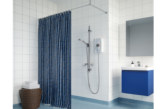
Hospitals are complex building types, often comprising a wide range of services and functional units, all of which inter-relate, so how do you optimise hygiene and what role does drainage play? Andy Buchan, divisional managing director of ACO Building Drainage, explains why drainage has such a fundamental impact on hygienic performance and the key specification factors every healthcare facility should consider.
Drainage is fundamental to the optimisation of hygiene in any building but in a hospital or healthcare environment it can have a significant impact on public health.
The diverse range of functions contained within a hospital, ranging from A&E through to catering and housekeeping, mean that specialist knowledge and expertise is required if the best outcomes are to be achieved for both patients and staff. Within this complex environment drainage systems play an important role, ensuring the removal of waste fluids while maintaining the necessary standards of hygiene.
Although patient and employee safety, hygiene, infection control and cost control are clearly all vital factors, for many healthcare facilities drainage is out of sight and therefore out of mind. As a result, many drainage systems are poorly designed and fail to optimise hygiene. At best this leads to a costly ongoing cleaning and maintenance programme, and at worst it can result in cross contamination and temporary closure of a facility.
So what do operators of healthcare facilities need to understand when it comes to drainage and what are the key considerations with regard to specification?
Healthcare facilities are obviously extremely sensitive environments and it’s important to consider every aspect of the drainage process from initial design and installation through to cleaning and maintenance.
Material choice
One of the first considerations is which material to use. Steel is widely considered to be the material of choice for a host of reasons, including its suitability for use in areas where specialist equipment such as MRI scanners are used. However, one of the commonly held misconceptions is that steel is clean. This is not true. A more accurate statement is that steel is cleanable and unlike many alternative materials such as plastic, it can be cleaned to the required standards.
When it comes to ‘cleanability’ and the likelihood that a drainage system could harbour bacteria, the design of your drainage has a significant impact.
In addition to making it as easy as possible to meet the requirements of the NHS Health Technical Memorandum 00 Policies and Principles of Healthcare Engineering, your drainage design should satisfy three key criteria: The facilitation of cleanliness and cleaning, the need to encourage desired behaviour and a requirement for easy cleaning.

To optimise cleanliness and cleaning, I’d advise healthcare facilities to only specify drainage products that are designed in accordance with the hygienic engineering design principles of the European Hygienic Engineering & Design Group (EHEDG) — a European organisation closely linked with the food manufacturing industry.
Like healthcare, food manufacturing is a hygiene-critical environment and there’s much to be gained by looking at what the food sector has learned and the best practice principals it has developed. Healthcare facilities also have additional hygiene issues caused by the random influx of the general public into their buildings, and this makes the specification of hygienically designed drainage even more important.
Engineered solutions
Hygienically engineered drainage systems are designed not to harbour bacteria and to minimise the build-up of harmful pathogens and biofilms. Key design features include a sleek slope function, rounded corners with a minimum radius of 3mm and hygienically designed foul air traps (FATs), which enable end users to benefit from a fully drainable system that has no stagnant odours caused by waste fluid.
To minimise the risk of bacterial growth throughout the drainage system, drainage also needs to be designed to connect hygienically with the surrounding floors — an often overlooked consideration.
When it comes to encouraging desired behaviours, your drainage should be easy-to-clean and disassemble. This makes cleaning a relatively quick and easy process while minimising the risk that cleaning operatives will take shortcuts in the cleaning process or even skip cleaning altogether.
For example, poorly designed foul air traps are often so hard to remove for cleaning that cleaners simply decide not to put them back in place or note to clean them. This enables unpleasant odours to enter a building. More importantly, it removes the barrier between the inside and outside world, enabling bacteria and other unwanted ‘guests’ to enter your facility.
Specification criteria
Functionally designed drainage will also minimise cleaning costs via the delivery of savings on manpower, detergents and downtime caused by cleaning or repairs.
With regard to easy cleaning and minimal maintenance, make sure your drainage and its cleaning requirements have been developed in partnership with premium cleaning agent suppliers and it is manufactured to high standards. For example, hygienic drainage should be made from fully pickle passivated steel for optimum durability and corrosion resistance — a factor which affects its hygienic performance, operational costs and product life.
By simply considering the specification criteria highlighted in this article, operators can improve the hygienic performance of their drainage and ensure it’s fit for purpose.
Drainage is a critical component when it comes to the control and prevention of healthcare-associated infection (HCAI) and the hygienic performance of a healthcare facility. Effective drainage helps mitigate hazards from the external environment and is also central to a safe and hygienic operation internally. Just as an effective facility needs excellent workers, effective tools and reliable equipment, a hygienically engineered drainage system is vital to the delivery of safe and efficient healthcare.


